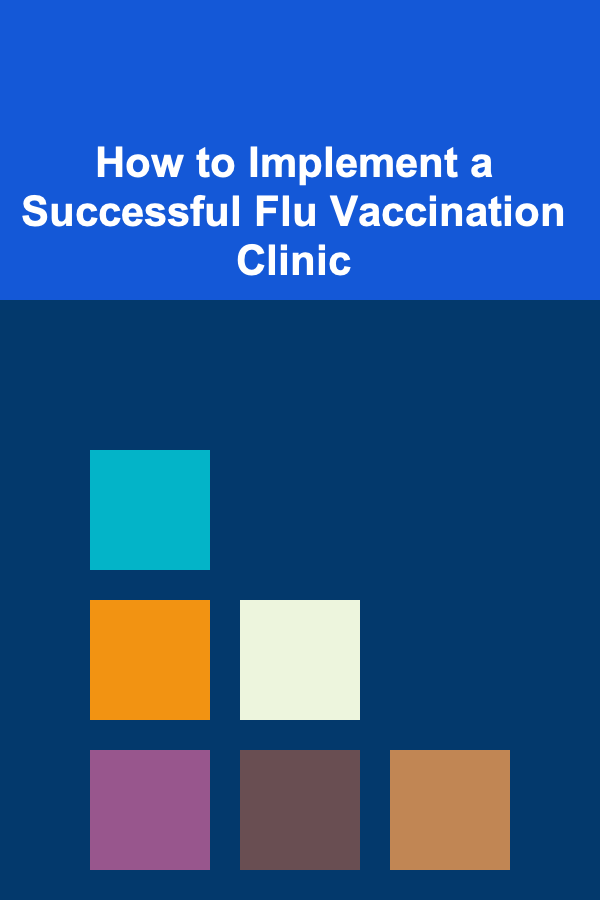
How to Implement a Successful Flu Vaccination Clinic
ebook include PDF & Audio bundle (Micro Guide)
$12.99$10.99
Limited Time Offer! Order within the next:

Implementing a successful flu vaccination clinic is critical to protecting public health, especially during peak flu season. Influenza, commonly known as the flu, is a highly contagious virus that can cause serious complications, particularly in vulnerable populations such as the elderly, young children, and individuals with preexisting health conditions. The success of a flu vaccination clinic depends on multiple factors, from preparation and organization to communication and follow-up. In this article, we will explore the essential steps needed to establish an efficient, effective flu vaccination clinic.
The Importance of a Flu Vaccination Clinic
The flu vaccine is one of the most effective tools in preventing the spread of the influenza virus. It reduces the risk of flu-related illness, hospitalization, and death. Despite the known benefits, vaccine uptake remains suboptimal in many communities, particularly among high-risk groups. Establishing a flu vaccination clinic can help improve vaccination rates by providing convenient access to the vaccine, educating the public about its benefits, and ensuring that people are protected against the seasonal flu.
A successful flu vaccination clinic provides more than just the vaccine; it creates an environment where individuals feel safe, informed, and supported in their decision to get vaccinated. By offering this service, healthcare providers can contribute to the overall public health effort to reduce the incidence of the flu and its associated complications.
Key Steps in Implementing a Successful Flu Vaccination Clinic
1. Planning and Preparation
A well-organized vaccination clinic requires careful planning and preparation. The planning phase should begin several months before flu season to ensure all logistical and operational aspects are in place.
a. Determine the Target Population: The first step is to define the population that the clinic will serve. While flu vaccinations are recommended for everyone aged six months and older, certain groups are considered high-risk, including:
- Elderly individuals aged 65 and older.
- Pregnant women.
- Children under 5 years old.
- People with chronic health conditions like asthma, diabetes, and heart disease.
Tailoring the clinic to meet the needs of these groups can help maximize the effectiveness of the clinic.
b. Choose the Right Location: The location of the vaccination clinic is crucial to its success. It should be easily accessible, convenient, and able to accommodate a high volume of patients. Considerations include:
- Proximity to public transportation.
- Availability of parking for patients.
- Space for vaccination booths, waiting areas, and storage for vaccines.
Community centers, schools, healthcare facilities, and pharmacies are all potential locations for hosting vaccination clinics.
c. Establish Partnerships and Collaborations: Collaborating with local healthcare providers, public health agencies, schools, businesses, and community organizations can help spread the word about the clinic and increase turnout. Partnerships may also help provide additional resources, such as volunteer staff or funding.
d. Budgeting and Funding: Establishing a budget for the clinic is an essential step. Funding for the clinic can come from various sources, including government grants, donations, or healthcare institution budgets. Consider all potential costs, such as:
- Purchase of flu vaccines.
- Staffing and volunteer compensation.
- Marketing and communication materials.
- Equipment and supplies (e.g., syringes, gloves, disinfectants).
2. Organizing the Logistics of the Clinic
Once the planning is complete, it is time to focus on the logistics of the clinic. This includes determining the number of staff needed, the registration process, and the flow of patients through the clinic.
a. Staffing and Training: The staff at the vaccination clinic plays a critical role in ensuring the clinic runs smoothly. This includes healthcare professionals (doctors, nurses, pharmacists) as well as administrative staff and volunteers. Training is essential to ensure that everyone is prepared to handle their responsibilities, such as:
- Administering vaccines safely and correctly.
- Handling adverse reactions to the vaccine.
- Assisting with patient registration and documentation.
- Providing education and answering questions about the flu vaccine.
b. Inventory Management: Managing vaccine inventory is crucial to avoid running out of vaccines or wasting doses. Keep track of the number of vaccines received, used, and remaining. It's essential to have a clear protocol in place for vaccine storage and handling, as flu vaccines must be stored at specific temperatures to maintain their effectiveness.
c. Clinic Flow and Patient Management: Organizing the clinic's flow is essential for providing a seamless experience for patients. A well-planned clinic layout should allow for:
- A check-in or registration area.
- Private vaccination stations for individuals.
- A waiting area for patients post-vaccination.
- Clear signage and instructions for patients.
Consider the amount of time needed for each individual vaccination. Ideally, the clinic should be organized to minimize waiting times and ensure that patients are observed for any potential allergic reactions or side effects after receiving the vaccine.
3. Promoting the Flu Vaccination Clinic
Effective promotion of the flu vaccination clinic is key to its success. Without proper outreach, individuals may not know about the availability of the vaccine or may be hesitant to get vaccinated. Use a combination of traditional and digital marketing strategies to spread awareness.
a. Community Outreach: Community engagement can help increase vaccine uptake, especially in communities with lower vaccine acceptance rates. Consider working with local schools, churches, businesses, and community leaders to promote the clinic. Utilize flyers, posters, and word-of-mouth campaigns to encourage individuals to get vaccinated.
b. Digital Marketing: In today's digital age, social media, email newsletters, and websites are essential tools for reaching a broader audience. Utilize platforms like Facebook, Instagram, Twitter, and local news outlets to promote the clinic. Include information such as:
- Clinic dates, times, and locations.
- Who should get vaccinated and why.
- What to expect during the clinic visit.
c. Public Service Announcements: Partner with local media outlets such as radio stations, TV channels, and newspapers to promote the clinic and educate the public about the importance of flu vaccination. Public service announcements (PSAs) can help address misconceptions and increase trust in the vaccine.
4. Executing the Vaccination Clinic
On the day of the clinic, the focus shifts to ensuring that everything runs smoothly. Effective execution requires attention to detail, teamwork, and flexibility to address any challenges that arise.
a. Registration and Screening: As patients arrive, they should be registered, and their eligibility for the vaccine should be verified. This process includes reviewing personal information, confirming that the individual is in the target age group, and ensuring there are no contraindications to receiving the vaccine (e.g., severe allergies to vaccine ingredients). Providing patients with information sheets about the vaccine and answering questions can help them feel more comfortable.
b. Vaccine Administration: Vaccines should be administered according to established guidelines. Healthcare providers should follow proper infection control practices, including:
- Using a clean needle for each injection.
- Administering the vaccine into the deltoid muscle.
- Monitoring for any immediate side effects or reactions.
c. Post-Vaccination Observation: After receiving the vaccine, patients should be monitored for at least 15 minutes (or 30 minutes for those with a history of allergic reactions) to ensure they do not experience an adverse reaction, such as anaphylaxis. Provide patients with guidance on potential side effects, such as soreness at the injection site, mild fever, or fatigue.
d. Handling Adverse Reactions: While adverse reactions to the flu vaccine are rare, they can occur. Ensure that staff are trained to recognize and respond to any potential issues, such as severe allergic reactions (anaphylaxis). Have emergency equipment (e.g., epinephrine) readily available, and ensure staff are familiar with how to use it in case of an emergency.
5. Follow-Up and Evaluation
The success of the flu vaccination clinic doesn't end after the final patient is vaccinated. Following up and evaluating the clinic's performance is critical to ensure continuous improvement for future clinics.
a. Post-Clinic Survey: Consider conducting a survey with patients to gather feedback on their experience. This can help identify areas for improvement in terms of clinic logistics, communication, and overall satisfaction.
b. Reporting and Documentation: Proper documentation of the clinic's activities is essential for both legal and operational purposes. Maintain accurate records of:
- The number of vaccines administered.
- Patient information (ensuring privacy and confidentiality).
- Any adverse reactions reported.
c. Reflecting and Improving: Use the feedback and documentation to assess the clinic's overall success and identify areas for improvement. This could include streamlining registration processes, adjusting staffing levels, or improving patient education efforts.
Conclusion
Implementing a successful flu vaccination clinic requires thoughtful planning, organization, and effective execution. By ensuring proper logistics, promoting the clinic effectively, and providing excellent patient care, healthcare providers can maximize vaccine uptake and contribute to the overall public health effort to prevent the flu. Additionally, by continually assessing and improving the process, future clinics can become even more efficient and accessible, ultimately saving lives and reducing the burden of influenza on individuals and communities alike. Through the collective effort of healthcare professionals, community partners, and the public, flu vaccination clinics can make a significant difference in reducing the impact of the flu season each year.
Reading More From Our Other Websites
- [Survival Kit 101] How to Customize a Survival Kit for High‑Altitude Mountaineering Expeditions
- [Sewing Tip 101] 10 Essential Hand‑Sewing Stitches Every Beginner Should Master
- [Toy Making Tip 101] Safety First: How to Choose Child‑Friendly Materials for Homemade Toys
- [Organization Tip 101] How to Store Travel Gear Neatly in Your Entryway
- [Home Budget 101] How to Save Money on Heating and Cooling Your Home
- [Personal Care Tips 101] How to Apply Dry Shampoo for a Fresh Look
- [Home Pet Care 101] How to Set Up the Perfect Aquarium for Fish
- [Home Pet Care 101] How to Maintain Your Pet's Mental Stimulation at Home
- [Personal Care Tips 101] How to Deal with Menstrual Cramps Naturally
- [Mindful Eating Tip 101] From Plate to Peace: The Science Behind Mindful Eating and Portion Awareness

How to Set Up a Capsule Wardrobe for Less Clutter
Read More
How to Use Sliding Doors for Space Efficiency in Small Rooms
Read More
10 Tips for a Productive Monthly Home Maintenance To-Do List
Read More
How to Use a Cooking Checklist to Reduce Food Waste
Read More
How to Plan a Holiday Budget That Works
Read More
10 Tips for Small Bathroom Makeovers
Read MoreOther Products

How to Set Up a Capsule Wardrobe for Less Clutter
Read More
How to Use Sliding Doors for Space Efficiency in Small Rooms
Read More
10 Tips for a Productive Monthly Home Maintenance To-Do List
Read More
How to Use a Cooking Checklist to Reduce Food Waste
Read More
How to Plan a Holiday Budget That Works
Read More